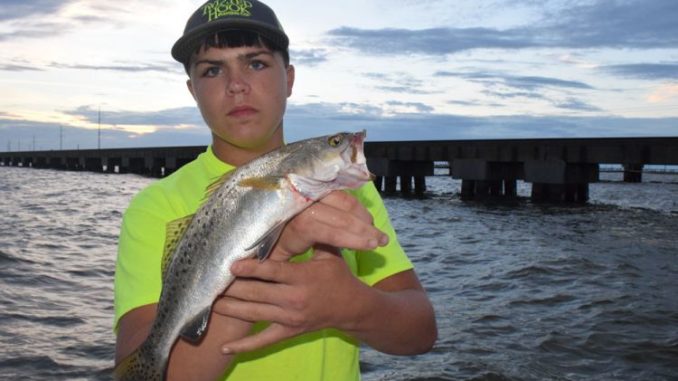
It’s not too late this month to target trout on the famed train bridge in Lake Pontchartrain. Find out why one guide believes the drop-shot rig is key to catching.
The legendary Trestles train bridge on Lake Pontchartrain is loaded with fish — and fishermen — every spring. When the speckled trout bite is super hot and winds are calm, the 5-mile-long bridge often has a boat on almost every piling.
This leads to lots of frustration among hard-core anglers. It’s not uncommon to cross lines with other fishermen, have boaters do doughnuts around your spot or have trollers weave in and out of your position.
And although there is less pressure this month, anglers still have to deal with tons of boats out on the water — there might be “only” 100 boats fishing the bridge — instead of 200.
But the boat pressure doesn’t faze Capt. John Falterman.
With the sun barely starting to show itself over the eastern horizon on the first day of the work week last June, Falterman parked his boat on the west side of the Trestles, just north of the draw bridge. But he wouldn’t have had a problem setting up anywhere else.
“We could go along pretty much this whole bridge and catch fish,” he said. “The bridge is way too long for everyone to be crowded up on everybody.”
What he would have a problem changing, though, is the setup he was fishing. Falterman is a big believer in the drop-shot rig, and it’s what separates his boat from the million others throwing the same bait.
“(With the drop-shot), the bait is always suspended, and the weight is always on the bottom,” he said. “It’s easier for people to feel.”
Soon after, Falterman began raking in speckled trout that couldn’t resist his offering of live shrimp.
The quality of the fish was impressive, but it certainly wasn’t abnormal for June, despite what many people think.
Falterman said most anglers believe there are only male trout left at the Trestles in June, but every year he demonstrates that’s false. In fact, on a trip he had early last summer, he said 90 percent of the fish he caught were females.
June may seem late to most people to fish the Trestles. The most common months to work the train bridge are in the fall and spring, but Falterman said anglers bypass the bridge too soon.
“It depends on how hot it gets, but I fish this bridge all the way into July,” he said. “Year after year, it changes, and that’s something you just have to figure out.”
Establish the pattern
When he first pulls up to the bridge, Falterman doesn’t just cast in one spot. He and his clients make multiple casts in different areas.
“We fan cast and see where they are holding,” he said. “Once you find out where they are, you can hone in on that one area, instead of bouncing back and forth.”
That’s exactly what Falterman did on this trip, when he took his son Jacob and two guests. After casting around the boat, Falterman and his son figured out the fish were hanging a good bit off the pilings.
Once that was established, the anglers didn’t waste any casts anywhere else.
Usually, Falterman has a specific side of the bridge he likes to fish.
“It’s pretty much all on the west side,” he said. “You have a lot more trollers on the east side.”
Although you can catch fish on plastics, having live shrimp is vital for fishing the Trestles in June. Falterman loads his baitwell up for a variety of reasons.
“Once the legs get eaten off and they’re not jumping around and being frisky, you attract more of the trash fish than you would a trout,” he said. “Although the shrimp are expensive, I’d rather have one good trout than take off croakers and catfish.”
Once he notices a shrimp is on its last leg, Falterman will reach his dip net in the bait well and scoop out a fresh, lively one.
The tides in Lake Pontchartrain are about as predictable as a teenaged girl. However, just because they’re hard to gauge, doesn’t mean you should ignore them.
“You can go on the north side (of the Trestles) and have a different tide movement than you will on the south side,” Falterman said.
The strength of the current dictates where the fish will be relative to the bridge.
“You can have the current to where it’s too strong, and they’re way off the bridge,” he said. “Sometimes, we’re throwing 100, 200 yards off the bridge.
“You’ll actually see the boats throwing behind, or they’re way out and throwing parallel with the bridge.”
Anchors away
Another thing Falterman does differently is how he anchors. Most anglers either drop an anchor overboard, or they tie up to the bridge.
Falterman isn’t a fan of either method, so he uses the Spot-Lock feature on his Minn Kota Ulterra.
“I don’t have to worry about pulling up an anchor, and also the noise of it,” he said. “I’m a big believer in not slamming lids or having an anchor-toss contest. I’ve seen them out here, and it’s like an Olympic event.”
With the self-releasing feature of the Ulterra, Falterman said it really helps out people with injuries.
“I got my first Ulterra right before I had back surgery, and it was a blessing having the trolling motor deploy itself, especially when it’s bumpy,” he said.





